 Healthy
Resources
Healthy
Resources

Dave Buscher's story of his exciting wilderness adventure, rafting down the Colorado River in the Grand Canyon, using a battery-operated, lightweight CPAP machine to treat his sleep apnea.
|

Phantom Sleep Resources TM
|
|
 Sleep
Apnea--the Phantom of the Night |
Table of Contents |
Introduction | Quiz
| About
the Authors | Reviews
|
S A L E Sleep Apnea—the Phantom of the
Night |
Flyer + Discount Orderform
Sleep
Apnea--the Phantom of the Night |
Table of Contents |
Introduction | Quiz
| About
the Authors | Reviews
|
S A L E Sleep Apnea—the Phantom of the
Night |
Flyer + Discount Orderform
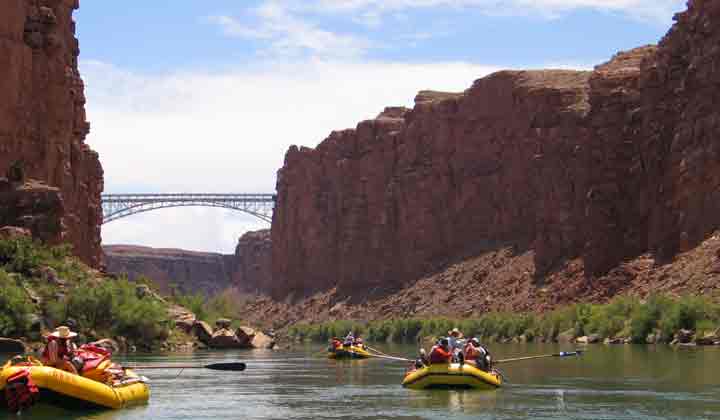
I have acute, obstructive sleep apnea and have used a Continuous Positive Air Pressure (CPAP) machine since 1993. This has never been a problem until I signed up myself and seven family and friends to take a raft trip down the Colorado River from Lee's Ferry to the Phantom Ranch. I was excited about the trip and it didn't really hit me when I sent in the deposit that there weren't convenient AC outlets for my CPAP machine along the way. [The Phantom Ranch has no connection to the "Phantom of the Night."—JH]
In February 2004 the planning began in earnest for the 25-30 July 2004 trip with OARS, Inc., the outfitter. There were two obvious problems - my overall physical condition for a challenging ride and the need to figure out how to power a CPAP for the four nights I would spend in a tent on the river and at Phantom Ranch on the fifth night. And another question arose---how was I going to get out of the Canyon, since the only available transportation from Phantom Ranch to the South Rim of the Grand Canyon was Shank's Mare?
My preparations included an updated sleep study, twice a week workouts with a personal trainer and finding how to run my CPAP without electric outlets and keep it dry while travelling over rapids.
The Lee's Ferry departure point was used by early settlers to cross the Colorado. Lee's Ferry is below the Glen Canyon Dam, near Page, Arizona, which holds back Lake Powell, named for John Wesley Powell. Powell, the first explorer of the Colorado, is the coiner of many of the feature names of the river and canyons he traveled in 1869 and 1871.
Finally on 25 July we were ready to board our rafts. Each raft was about 18 ft. long and 8 ft. wide. Four rafts had a guide/oarsman and 3 or 4 customers since there were 15 of us heading down the river in a paying capacity. There were also two supply rafts, each with two people and the bulk of the supplies. Our rafts were rowed and did not have motors. The rafts carry everything including tents, sleeping kits, food, waste of all kinds (don't ask), tables and chairs, cooking materials and all personal equipment. Each customer is limited to a 30 lb. duffle, stored in a waterproof bag, and a small day pack for use on hikes during the trip and for the long trek out of the Canyon.
Our group of 23 was a small part of the 22,000 people that venture down the Colorado each year. The trip is 87 river miles and takes 5 days and 4 nights. Rapids on the river are designated as Class 1 through 10 with names like Badger Creek, Sheer Wall, Nankoweap, Kwagunt, and Hance Rapids—rated 7-8 and the biggest rapids of our trip. Many of the rapids are capable of flipping a raft on a whim, so everything is tied down and protected by waterproof bags and containers.
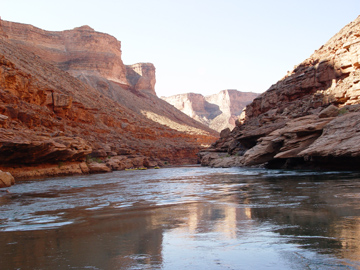
Our guides - Robbie (lead), The Doctor (chronicler of the area with 4 books to his credit), Billie (the lone female guide who started rowing as a pre-teen) and Fabrey (local wit) were well versed in both the lore of the river and the geology of the canyons we passed through as we descended about 1.7 billion years in geologic time. They also shared some of their favorite questions from travelers such as "How far back do the walls go?"; "How much does the Canyon weigh?"; and my favorite "How far below sea level are we?"
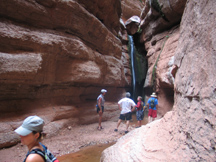
The trip was not only a scenic wonder both on and off the river, but a chance to unwind and meet some interesting people. Besides our contingent of my three sons (no, not the Fred MacMurry variety for you old-timers -- I have two additional sons who didn't make the trip), a daughter-in-law and one fiancé, and an old friend and his son, we had the pleasure of traveling with a geologist/professor and his teenage son, a mother and financial advisor/professor and her two teenage daughters and two madcap sisters from Massachusetts and Texas. Side hikes, nightly down time, sharing rafts and meal times provided ample time to get to know the fellow explorers and our guides and support crew. Pictures from two of my sons, one a professional photographer (can you figure out which one) are featured in this article.
We didn't suffer on the river from lack of good food. Breakfasts includes eggs to order, pancakes, sausage, bacon, cereal, hot chocolate, coffee, juice and various breads. Lunch included fruit, lunch meats, peanut butter, cream cheese and black olives, cookies, tuna salad, tomatoes and lettuce and snacks. Dinner highlights included hamburgers, salmon, chicken and spaghetti with deserts including fresh baked brownies and a cake.
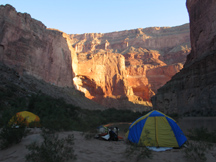
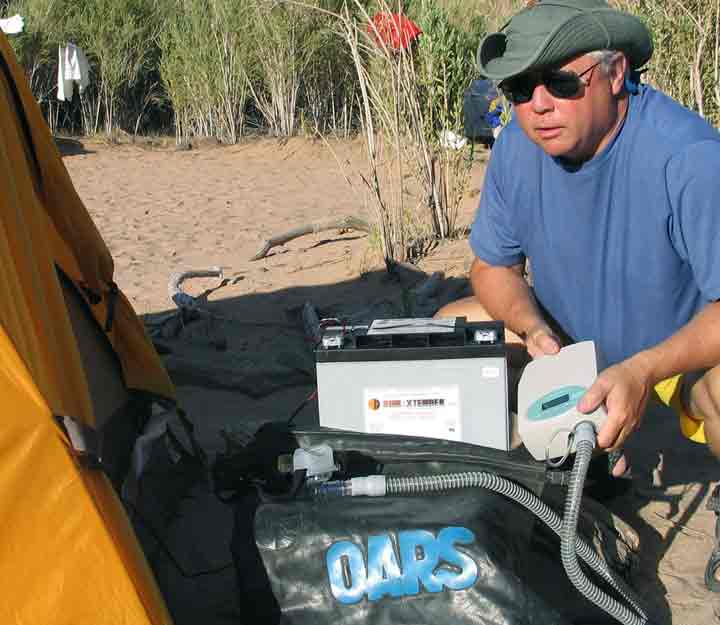
I have a reputation for having strange things happen to me wherever I go and this trip was no exception. Somehow, I got stung by a scorpion in the raft which is a bit strange in itself. The sting was on my left foot and can best be described as feeling like a hot ice pick that someone continues to twist. The guides were on the ball when it came time to diagnose and treat my scorpion sting. The treatment of choice was the cold water of the river which was about 50 degrees. The water would numb the sting enough so I was able to sleep in 20 min. increments during the 4th night on the river. At Phantom Ranch, river water was replaced by ice and by the morning of the grand hike out the pain had subsided. Apparently different scorpion types have other symptoms that I don't plan to sample anytime soon.
We arrived at the Phantom Ranch about 1 PM of the 5th day and had our first hot shower of the week. Not even the tarantula in one shower could deter us from reveling in water coming from a spigot rather than from the river. The sleeping arrangements were small cabins with bunkbeds, but also air conditioning. After temperatures that reached 107 degrees on the river this was a real treat. A canteen and dining hall with long common tables provided our first meal indoors. The food was served family style and was a hearty and apparently famous beef stew.
We all awoke at about 5AM at Phantom Ranch for a hearty family style breakfast so we could get started as early as possible before the heat became intolerable. Each person had a 30 lb allotment that would be carried out by pack mules. My allotment included my CPAP as well as the clothes and other things I wouldn't need on the hike out. Our day packs carried a bag lunch prepared by the Ranch, extra socks and in some cases shoes, cameras and lots of water. Most people carried at least 2 liters of water and I was packing 5 just in case. The first 5 miles of the trip took us to Indian Gardens. It was about 1/2 of the distance, but only about 1/3 of the elevation.
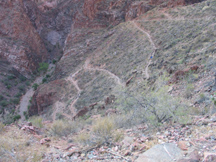
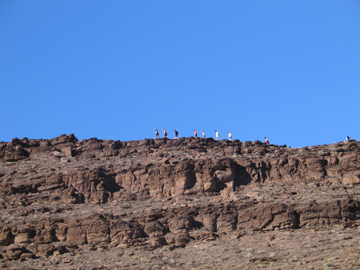
Various people quickly found their own pace and three groups resulted. Each group had a GPS display and radio so we could keep track of each other. The gazelles were two sons and their young ladies who were all in good shape and had been training for the journey. The wise ones were two over-50 guys who had trained vigorously for the trek, but had less to work with than the young folks; and then there were the two plodders who trained for the hike on their way out of the Canyon. The gazelles made the trip in about 4.5 hrs and gave us a glimmer of what was to come via radio. The wise ones made it to Indian Gardens in less than 3 hrs., but then took six more hours to reach the South Rim. The plodders surfaces at the South Rim two hours after the wise ones. All had faced their own unique challenges and accomplished a feat that they will always remember.
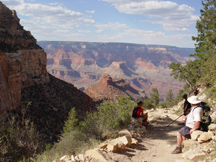
This trip was made possible by finding a way to use my CPAP where no CPAP had gone before. I began with research of the available literature on portable CPAPs. Most of what I found was sketchy and oriented to an at home battery backup for CPAP. My requirements were more demanding because the trip would last several days in a difficult environment. In addition to finding a portable power source, I would need to protect my CPAP from heat, sand, and water, and from the real possibility it could be lost overboard.
Preparing for the trip involved research to find a portable CPAP; I selected a very small CPAP by Puritan Bennett (GoodKnight 420S) that had the added advantage of being powered by a 12 V DC source. I did some tests and figured I needed about 64 ampere hours of power and opted for a 100 ampere hour battery just in case. Battery research quickly focused on deep discharge marine batteries and the obvious choice for the raft environment was Absorbed Glass Mat (AGM) technology (Concorde Battery PVX-1040T) since I couldn't count on the orientation of the battery on the raft and a swim in the river was a real possibility if a raft flipped. AGM batteries can cost about twice as much as traditional lead-acid batteries like you use in your car, but are sealed instead of vented. A fibrous glass mat holds the electrolyte fluid captive and thus prevents spills, and also provides pockets that assist in the recombination of hydrogen and oxygen gasses. They don't outgas and this was important because of the waterproof storage used on the rafts [ordinary, vented batteries can release hydrogen and oxygen, potentially causing an explosion].
Ordering the CPAP on-line was relatively easy, compared to finding the right battery, since my doctor was willing to send a prescription to the provider. I found that the battery was more of a problem since it is relatively hard to stick a few stamps on a 66 pound battery and send it across the country. The solution was to order the battery from Northern Arizona Wind and Sun (which is located in Flagstaff where our trip originated) and arrange for someone from OARS to pick it up the week before the trip. It took a bit of extra coordinating, but the exchange was made and OARS had the battery in its Flagstaff warehouse when I arrived the day before the trip.
An optional battery power cord had been ordered with the CPAP to attach to the terminals of a battery. Since I only received the battery the night before we boarded the rafts, I had to adapt the power cord connectors to the battery terminals. There was a bit of guessing on what was needed to connect the special cord required for the CPAP. I bought some battery terminal adapters at a local Flagstaff auto supply store that turned out to not quite match the screw terminals on the battery. However, I was able to borrow a wrench from OARS, and with some machine screws supplied with the battery I was able to connect the special cord to the battery. OARS then took the battery and made sure it was placed on the raft in a waterproof bag.
It was a little cumbersome carrying around a 66 lb. battery, but it soon became a normal chore. However, the battery and the CPAP worked flawlessly during the trip even in the sandy camp sites. I didn't have the ability to measure the reserve capacity of the battery, but there was no evidence it was low on charge at the end of the trip. Because of the difficulty of retrieving the battery by mule from the Phantom Ranch, I donated it to the folks at OARS who would retrieve it when they brought the rafts and supplies from the river several days hence.
For me, the cost and effort of dealing with the battery and the CPAP was well worth it because the trip was fantastic. And yes I did sleep like a baby, except for the night of the scorpion sting.
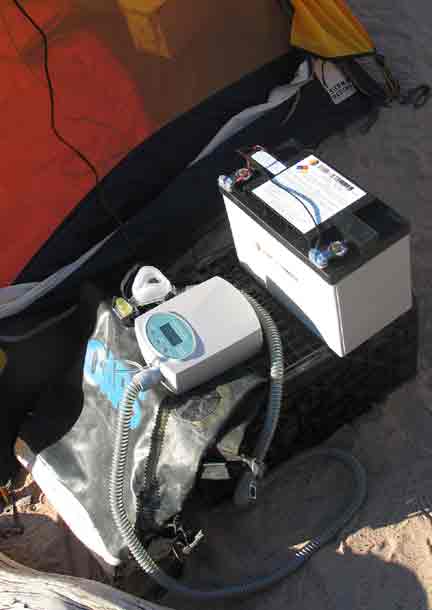
All material on this site is Copyright © 1995-2010 New Technology Publishing, Inc. All rights reserved. For links policy, and Trademark Notices, please see: Copyright and Links In reviews or articles based on "fair use" of this copyrighted material, please reference as your source: Healthy Resources and New Technology Publishing, Inc., http://www.healthyresources.com, http://www.newtechpub.com Privacy Policy
Our publications (online, email, print, or any other communications or phone contacts) do not provide medical advice or a professional service. No one including the publisher, editors, editorial advisors, or the authors of any material in this site is engaged in providing any medical or professional advice or services through the publication, distribution or sale of articles, books, materials, tests or quizzes, on this site or in communications by phone, email, or any other means. Persons with suspected or diagnosed sleep apnea syndrome or any sleep disorder or other condition including COPD discussed in this site should consult with a physician and other qualified professionals for advice concerning their own treatment.